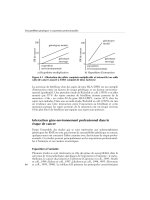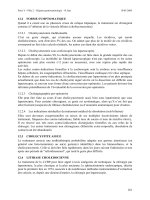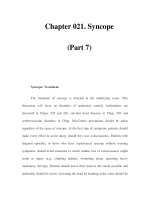Chapter 106. Plasma Cell Disorders (Part 7) potx
Bạn đang xem bản rút gọn của tài liệu. Xem và tải ngay bản đầy đủ của tài liệu tại đây (50.06 KB, 5 trang )
Chapter 106. Plasma Cell Disorders
(Part 7)
Serum β
2
-microglobulin is a protein of 11,000 mol wt with homologies
with the constant region of immunoglobulins that is the light chain of the class I
major histocompatibility antigens (HLA-A, -B, -C) on the surface of every cell.
Serum β
2
-microglobulin is the single most powerful predictor of survival and can
substitute for staging. Patients with β
2
-microglobulin levels <0.004 g/L have a
median survival of 43 months and those with levels >0.004 g/L only 12 months.
Serum β
2
-microglobulin and albumin levels are the basis for a three-stage
International Staging System (ISS). It is also felt that once the diagnosis of
myeloma is firm, histologic features of atypia may also exert an influence on
prognosis. IL-6 may be an autocrine and/or paracrine growth factor for myeloma
cells; elevated levels are associated with more aggressive disease. High labeling
index and high levels of lactate dehydrogenase are also associated with poor
prognosis.
Other factors that may influence prognosis are the number of cytogenetic
abnormalities including hyperploidy, chromosome 13q and 17p deletion, t(4;14)
and t(11;14); % plasma cells in the marrow; circulating plasma cells; performance
status; as well as serum levels of soluble IL-6 receptor, C-reactive protein,
hepatocyte growth factor, C-terminal cross-linked telopeptide of collagen I,
transforming growth factor (TGF) β, and syndecan-1. Microarray profiling and
comparative genomic hybridization have formed the basis for RNA- and DNA-
based prognostic staging systems, respectively. The ISS system is the most widely
used method of assessing prognosis (Table 106-3).
Multiple Myeloma: Treatment
About 10% of patients with myeloma will have an indolent course
demonstrating only very slow progression of disease over many years. Such
patients only require antitumor therapy when the disease becomes symptomatic
with development of anemia, hypercalcemia, progressive lytic bone lesions
(including vertebral compression fractures), progressive rise in serum myeloma
protein levels and/or Bence Jones proteinuria, or recurrent infections. Patients with
solitary bone plasmacytomas and extramedullary plasmacytomas may be expected
to enjoy prolonged disease-free survival after local radiation therapy to a dose of
around 40 Gy. There is a low incidence of occult marrow involvement in patients
with solitary bone plasmacytoma. Such patients are usually detected because their
serum M component falls slowly or disappears initially only to return after a few
months. These patients respond well to systemic chemotherapy.
Patients with symptomatic and/or progressive myeloma require therapeutic
intervention. In general such therapy is of two sorts: systemic therapy to control
the progression of myeloma, and symptomatic supportive care to prevent serious
morbidity from the complications of the disease. Therapy can significantly
prolong survival and improve the quality of life for myeloma patients.
The initial standard treatment for newly diagnosed myeloma is dependent
on whether or not the patient is a candidate for high-dose chemotherapy with
autologous stem cell transplant.
In patients who are transplant candidates, alkylating agents such as
melphalan should be avoided since they damage stem cells, leading to decreased
ability to collect stem cells for autologous transplant. High-dose pulsed
glucocorticoids have been used either alone (dexamethasone 40 mg for 4 days
every 2 weeks) or in combination VAD chemotherapy (vincristine, 0.4 mg/d in a
4-day continuous infusion; doxorubicin, 9 mg/m
2
per day in a 4-day continuous
infusion; dexamethasone, 40 mg/d for 4 days per week for 3 weeks) for initial
cytoreduction. However, two studies have combined thalidomide with
dexamethasone as initial therapy for newly diagnosed multiple myeloma in
transplant candidates and reported rapid responses in two-thirds of patients, while
allowing for successful harvesting of peripheral blood stem cells for
transplantation. A randomized phase III trial showed statistically significantly
higher response rates for thalidomide (200 mg PO qhs) plus dexamethasone (40
mg for 4 days every 2 weeks) compared to dexamethasone alone, setting the stage
for use of this combination as standard therapy in newly diagnosed patients. Initial
therapy is continued until maximal cytoreduction. Importantly, novel agents
bortezomib, a proteasome inhibitor, and lenalidomide, an immunomodulatory
derivative of thalidomide, have similarly been combined with dexamethasone and
obtained high response rates without compromising collection of stem cells for
transplantation.
In patients who are not transplant candidates, therapy has consisted of
intermittent pulses of an alkylating agent, L-phenylalanine mustard (L-PAM,
melphalan) and prednisone administered for 4–7 days every 4–6 weeks. The usual
doses of melphalan/prednisone (MP) are melphalan, 8 mg/m
2
per day, and
prednisone, 25–60 mg/m
2
per day for 4 days. Doses may need adjustment due to
unpredictable absorption and based on marrow tolerance. Patients responding to
therapy generally have a prompt and gratifying reduction in bone pain,
hypercalcemia, and anemia, and often have fewer infections. The serum M
component lags substantially behind the symptomatic improvement, often taking
4–6 weeks to fall. This fall depends on the rate of tumor kill and the fractional
catabolic rate of immunoglobulin, which in turn depends on the serum
concentration (for IgG). Light chain excretion, with a functional half-life of ~6 h,
may fall within the first week of treatment. However, since urine light chain levels
may relate to renal tubular function, they are not a reliable measure of tumor cell
kill. Calculations of tumor cell kill are made by extrapolation of the serum M
component level and rely heavily on the assumption that every tumor cell
produces immunoglobulin at a constant rate. About 60% of patients will achieve at
least a 75% reduction in serum M component level and tumor cell mass in
response to melphalan and prednisone. Although this is a tumor reduction of <1
log, clinical responses may last many months. The important feature of the level of
the M protein is not how far or how fast it falls, but the rate of its increase after
therapy. Efforts to improve the fraction of patients responding and the degree of
response have involved adding other active agents to the treatment program. In
patients >65 years, combining thalidomide with MP (MPT) obtains higher
response rates and overall survival than MP alone, and MPT is the standard
therapy for patients who are not transplant candidates.









